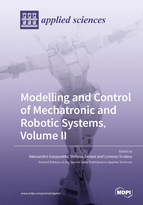Modelling and Control of Mechatronic and Robotic Systems, Volume II
A special issue of Applied Sciences (ISSN 2076-3417). This special issue belongs to the section "Mechanical Engineering".
Deadline for manuscript submissions: closed (31 May 2022) | Viewed by 54655
Related Special Issue: Modelling and Control of Mechatronic and Robotic Systems
Special Issue Editors
Interests: robotics; trajectory planning; modeling of mechatronic systems
Special Issues, Collections and Topics in MDPI journals
Interests: space robotics; rovers; mobile robotics; autonomous systems; modular systems; industrial robotics; cable robots
Special Issues, Collections and Topics in MDPI journals
Interests: robotics; mechatronics; kinematics and dynamics; trajectory planning; collaborative robotics; mechanics of vibrations; mobile robotics; agricultural robotics
Special Issues, Collections and Topics in MDPI journals
Special Issue Information
Dear Colleagues,
The modeling and control of mechatronic and robotic systems is an open and challenging field of investigation in both industry and academia. The modeling of a mechanical system is fundamental in the development of experimental prototypes. The kinematic model of a mechatronic or robotic system is essential for the proper definition of the path that the system has to follow during its operation. Dynamic modeling makes it possible to simulate and predict scenarios and working conditions, and to evaluate the system’s time-dependent evolution and response under different input conditions. Indeed, a proper model can be used to improve the design and performance with different objectives: vibration reduction, energy consumption minimization, path and trajectory planning optimization, as well as improvement of control and tracking performance. Within this framework, the proper control of an automatic system is essential for successfully completing a predefined task, even in the presence of external disturbances. Finally, the design of proper controllers for robots and automatic machines is crucial when dealing with flexible systems in which mechanical vibration and noise have to be taken into account.
This Special Issue of the journal Applied Sciences encompasses the modeling, analysis, design, and control of mechatronic and robotic systems, with the aim of improving the performance and design of such systems.
We invite contributions to this Special Issue on topics including but not limited to the following:
- Modelling of mechatronic and robotic systems:
- Kinematic modeling;
- Dynamic modeling;
- Path and trajectory planning:
- Navigation;
- Obstacle avoidance;
- Motion planning;
- Control systems;
- Optimization of mechatronic and robotic systems with respect to:
- Mechanical vibration and noise;
- Energy consumption;
- Kinematic and dynamic behavior;
- Tracking performance;
- Applications including, but not limited to:
- Robotics;
- Collaborative robots;
- Mechatronics;
- Flexible and compliant multibody systems;
- Manufacturing systems.
Prof. Dr. Alessandro Gasparetto
Dr. Stefano Seriani
Dr. Lorenzo Scalera
Guest Editors
Manuscript Submission Information
Manuscripts should be submitted online at www.mdpi.com by registering and logging in to this website. Once you are registered, click here to go to the submission form. Manuscripts can be submitted until the deadline. All submissions that pass pre-check are peer-reviewed. Accepted papers will be published continuously in the journal (as soon as accepted) and will be listed together on the special issue website. Research articles, review articles as well as short communications are invited. For planned papers, a title and short abstract (about 100 words) can be sent to the Editorial Office for announcement on this website.
Submitted manuscripts should not have been published previously, nor be under consideration for publication elsewhere (except conference proceedings papers). All manuscripts are thoroughly refereed through a single-blind peer-review process. A guide for authors and other relevant information for submission of manuscripts is available on the Instructions for Authors page. Applied Sciences is an international peer-reviewed open access semimonthly journal published by MDPI.
Please visit the Instructions for Authors page before submitting a manuscript. The Article Processing Charge (APC) for publication in this open access journal is 2400 CHF (Swiss Francs). Submitted papers should be well formatted and use good English. Authors may use MDPI's English editing service prior to publication or during author revisions.
Keywords
- robotics
- mechatronics
- control
- dynamics
- trajectory planning
- mobile robotics








